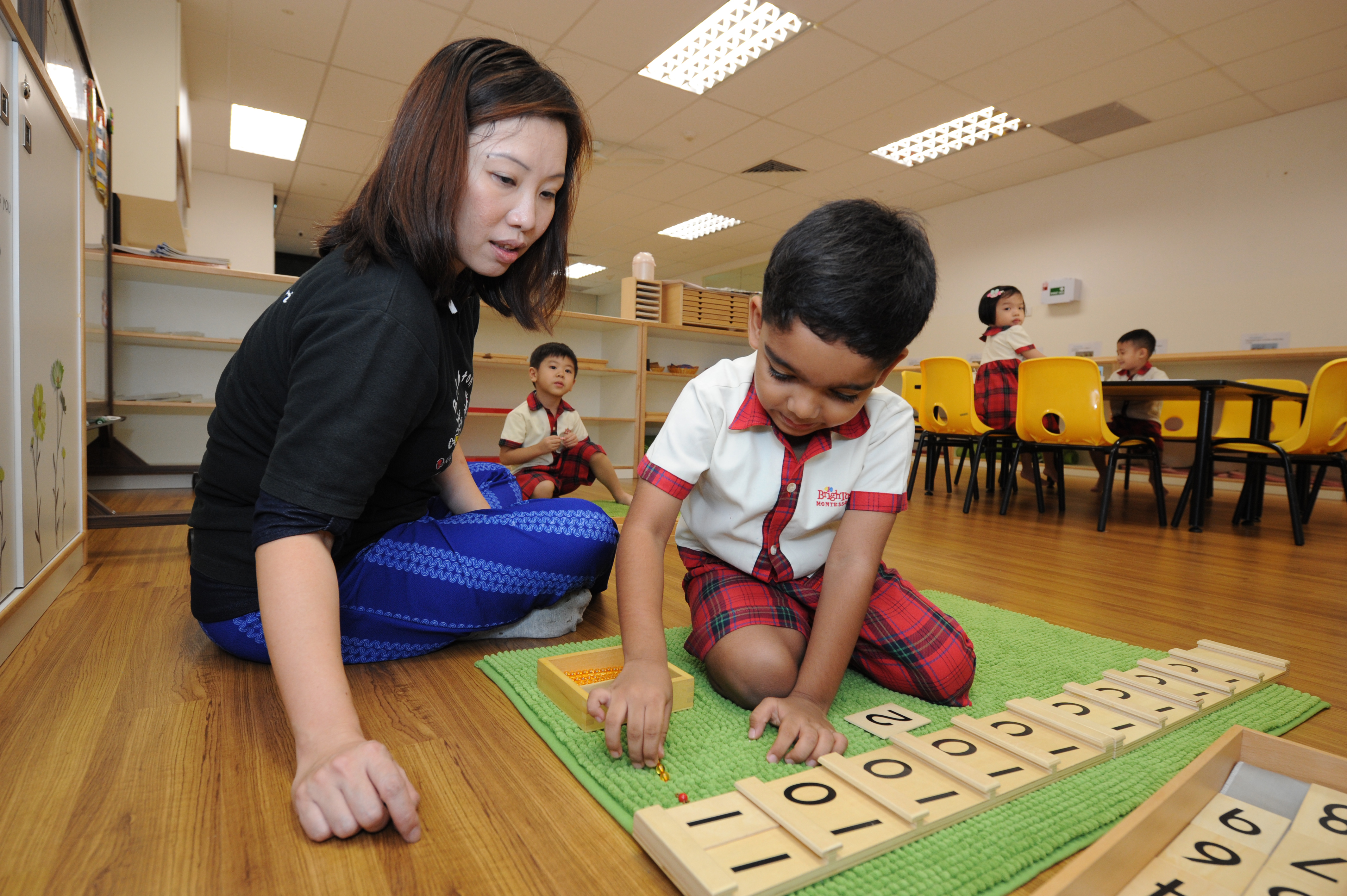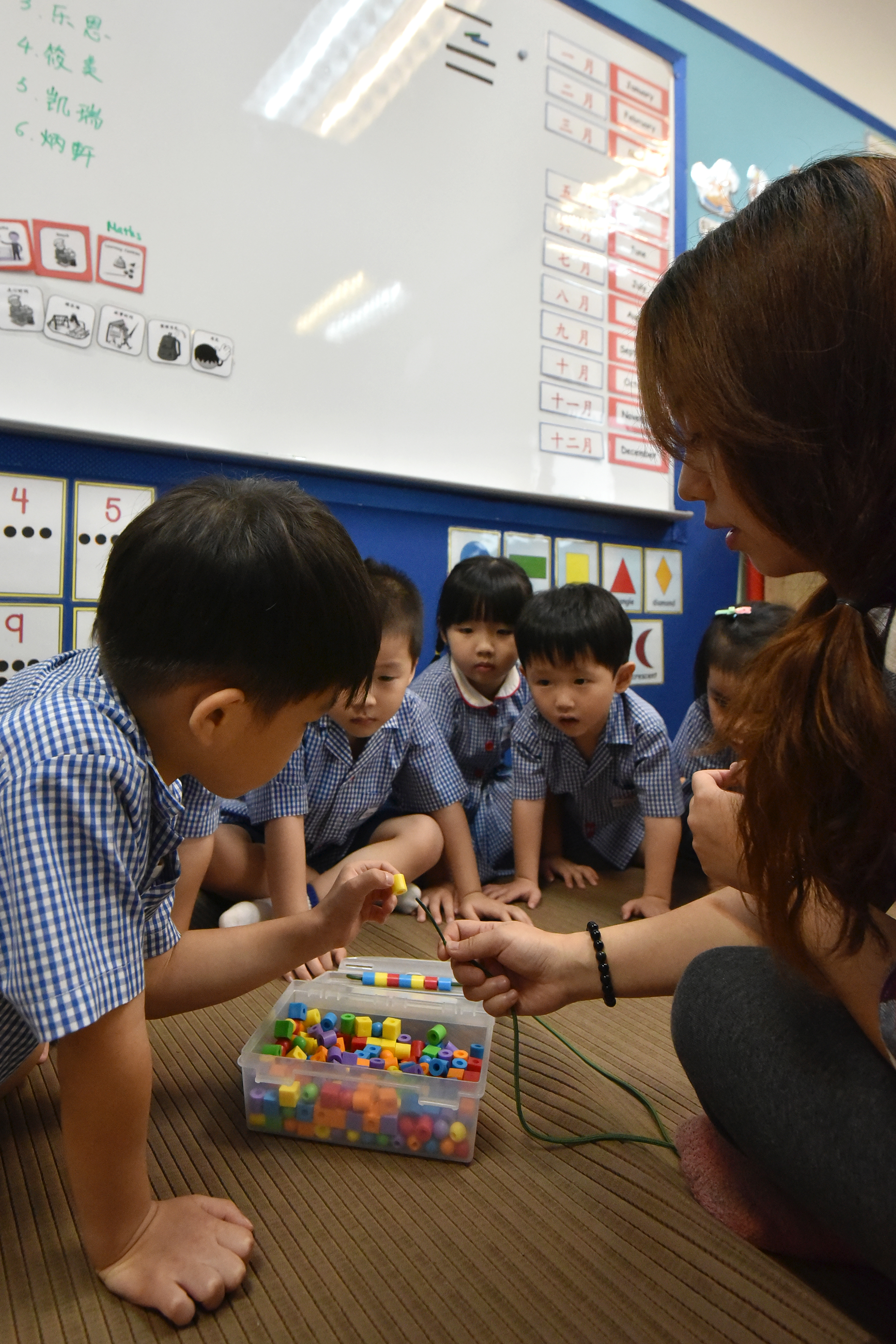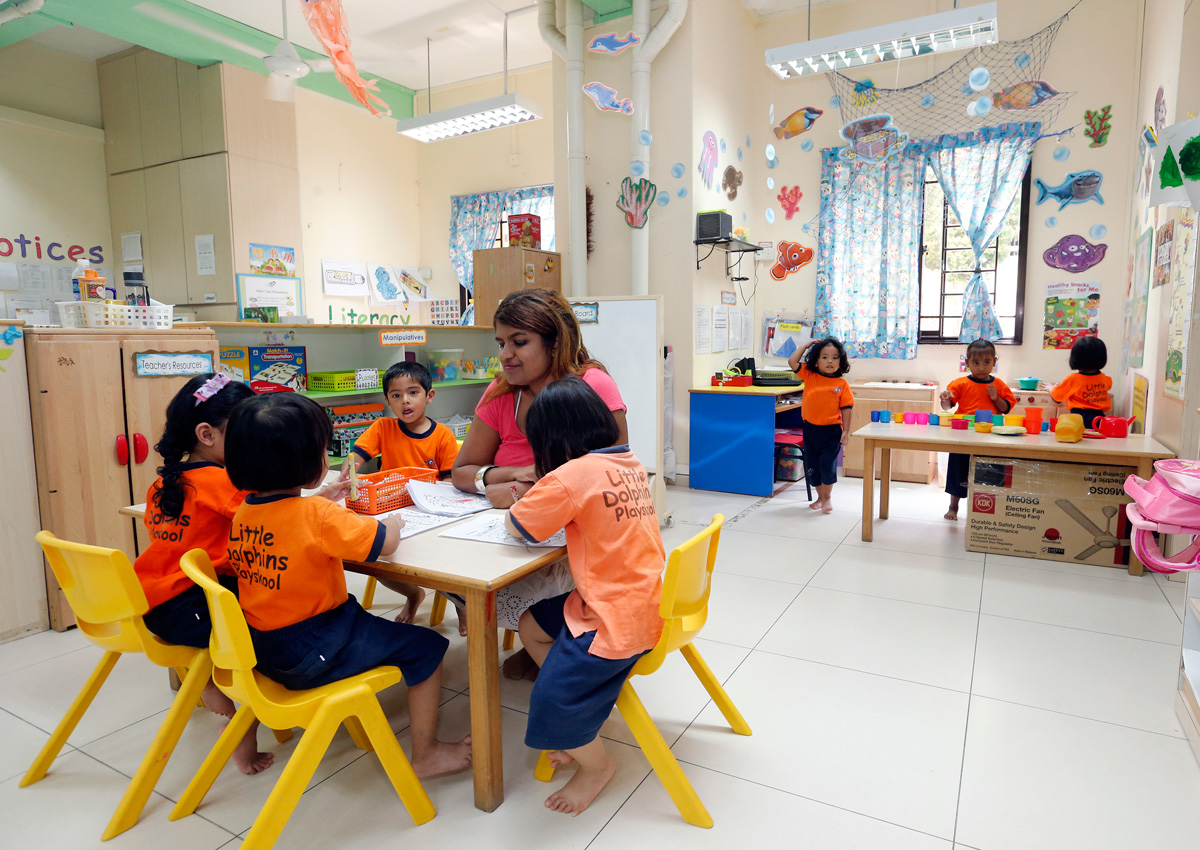Imparting values through incidental learning
Under $600/month
The pre-school is in an HDB void deck, but has open-concept classrooms on the second floor of the block too.
The walls inside are filled with things such as the children’s artworks or posters, vastly different from the mostly bare ones at the Brighton Montessori centre that ST also visited.
For instance, there are 20 to 30 clear folders stuck on the walls in an area where the Nursery 2 (N2) class is held. Each holds a worksheet – or “activity sheet” as the teachers call it – of every child in the class.
Examples of activity sheets include one in which children pasted drinking straws of different lengths on paper, to learn what is considered long or short; another in which children pasted the tags found on packs of bread, and they had to count the number of tags and write the corresponding number.
Said principal Nyo Cheng Cheng: “The activity sheets are meant to document their learning journey.
Kids also take pride in their work and take ownership of their class environment when their work is displayed.”
Also on display are children’s artworks and an ST article, put up under a “current affairs” section.
The article is about how more parks are being set up to save an endangered monkey species from extinction; and next to the article are pointers such as “Do not scare the monkeys”.
Everyday items in the class – such as the air-conditioner, the fan and the clock – are labelled too, in English and Chinese. Class rules – such as a poster with a picture and words to tell children to sit cross-legged – are also pasted on the wall.
Children in the N2 class seemed to have learnt the class rules well. Many raised their hands before answering the teacher’s question of what English words start with “G”.
A Malay teacher did the English lesson with 15 children, with a Chinese teacher sitting nearby.
Later on, when some children rushed forward to get their chance to take part in an activity, a teacher praised a pupil at the back who raised her hand while waiting quietly for her turn.
Ms Nyo said: “We emphasise core values, like respect and integrity, through incidental learning, and the current affairs lessons held every two weeks, for instance.
“The topics discussed are usually those in which we can impart values and good habits such as recycling.”
PCF SPARKLETOTS
WHERE: Block 115, Bedok North Road
FEES: $578.50/month for full-day childcare, after GST, from July
RUN BY: PAP Community Foundation, an anchor operator which gets government grants
STAFF: 16 teachers, including 14 with a diploma in pre-school education and two with a degree or higher in the same field
CAPACITY: 126 childcare places
Priority admission for kids from needy families
$600/month
In this pre-school in the void deck of a Housing Board block, only a few resource rooms have air-conditioning, and the other areas have only fans. But the children do not seem to mind.
Like most centres sited in void decks, it has about 100 places, including 20 for infantcare.
It is one of two childcare centres run by the United Indian Muslim Association, a charity which gives annual education bursaries and runs community programmes such as cross-cultural dialogues.
Most of its teachers are Indians or Malays, and they speak English during lessons, though they sometimes say “sayang” (Malay for “dear”) when calling the children.
The centre has children of all races and religions, and offers mother tongue lessons in Chinese, Malay and Tamil.
Children mainly live nearby, and those from low-income families get priority admission.
Principal Noor Basriah Abdul Khader said: “We want to give the child a place first, so if the mother is not working, it is more convenient for her to look for a job.”
When The Straits Times sat in on a Nursery 2 (N2) class recently, it was noisy, with children talking or singing. At times, a few N2 children were distracted and looked at another class nearby that was singing. There were two teachers with 16 children in the N2 class.
While there are rooms within the centre, it adopts an open concept, with classes separated by shelves.
It has four themes for the curriculum each year.
When The Straits Times visited, the theme was on food. The N2 children learnt to identify different types of food as part of language and literacy, and craft lessons were related to food too.
The curriculum also covers motor skills, music and movement, and numeracy.
At one point, the class was divided into smaller groups for different activities.
Five children had a craft lesson on how to make a “burger mobile”, or a paper burger with different layers. A circular piece of paper coloured green was used to represent lettuce, for instance.
There are toys on the shelves, such as a game that required players to match words with pictures.
Ms Basriah said: “Good-quality programmes are not about high- end toys, but about how teachers engage children with the toys.”
LITTLE DOLPHINS PLAYSKOOL
WHERE: Block 714, Clementi West Street 2
FEES: $600/month for full-day childcare, no GST charged
RUN BY: A charity
STAFF: 15 teachers, including seven with a diploma in pre-school education
CAPACITY: 80 childcare places
Teaching how to focus and tune out distractions

Over $1,500/month
The walls have large posters of children in Brighton Montessori uniforms, but are otherwise quite bare.
Resource materials, such as coloured beads and number boards, are neatly kept on shelves and look new. Some are kept in labelled plastic containers; others are in light brown, wooden boxes.
The materials are Montessori’s, and the bare walls are part of the Montessori approach too, said principal Hairumbiyah Ghabi, better known as Ms Biyah.
The Montessori education method for children was founded in 1907 by Italian early childhood pioneer Maria Montessori. It uses a tailored approach to develop a person’s unique abilities.
Part of the Montessori approach involves dividing classes into small groups for activities. There is more individualised learning when teachers guide children in using the Montessori materials.
On the somewhat sterile look of the centre, Ms Biyah said: “We want the children to be focused. If the environment is too cluttered, they get distracted.”
Generally, the younger children are in rooms within the centre, with N2 and K2 pupils in open areas.
The rest of the centre has a more open concept, with classes being separated by shelf partitions.
The N2 class that The Straits Times visited was supposed to have 26 children, though about 10 of them were not around – some had gone overseas for a holiday and others were foreigners who had gone back to their countries for a visit.
There were three teachers who taught in English and one in Mandarin, with the N2 class divided into three groups.
Senior teacher Pauline Yong, who was teaching seven children, focused on two children who each used a Montessori material called a Seguin board. This is a board with numbers on it to teach children the concept of tens and ones for two-digit numbers.
For “11”, for instance, they would count 11 beads, place them near the top of the board, and slot a piece with “1” on it in the ones place at the top of the board.
“They move from doing something concrete with counting beads to the abstract of recognising the numeric symbols,” said Ms Yong.
The other five children were independently, quietly tracing the letter “p” on worksheets, to revise the alphabet letters they had learnt.
All through the visit, even if a nearby class was loudly reciting Chinese words or singing, the N2 group focused on the task in front of them.
“They know our system. They know I’m with the children using the Montessori materials and they’ll have their turn later. When they’re focused, they can also tune out noise from other classes,” said Ms Yong.
BRIGHTON MONTESSORI
WHERE: The Grassroots’ Club in Ang Mo Kio
FEES: $1,605/month for full-day childcare, after GST
RUN BY: A commercial operator
STAFF: 21 teachers, including 13 with a diploma in early childhood education
CAPACITY: 144 childcare places
Language immersion at Chiltern House

Over $2,000/month
At Chiltern House, every class has its own room and there is an indoor playground, which may not be the case at most pre-schools.
When ST visited its Nursery 2 (N2) class recently, no noise from outside could be heard.
Said principal Iris Lim: “We allow the kids to speak up and express themselves. If the centre had an open concept, it’d be difficult to focus on what the children are talking about.”
Its N2 class was exceptionally small – there were just six children with two teachers in class.
The pre-school sets a ratio of one teacher to seven children, and there are 14 places for the N2 full-day programme, but only seven are filled. One was absent when I visited.
Ms Lim said parents are more keen on its half-day programme.
The pre-school is in an exclusive club – only around 1 per cent of centres here charge more than $2,000 a month. Most pupils at the pre-school, which is on the second floor of the SLF Building in Thomson Road, are from the nearby Newton or Thomson areas.
The Chinese teachers, mostly from China, have lived here for several years so their mainland accent is not too strong.
Ms Lim said there is much communication between parents and teachers. “The teachers talk to the parents, sometimes every day, so there’s rapport built.”
The pre-school is under the Julia Gabriel Education group and named after Chiltern, in south central England, where Ms Gabriel’s parents’ home is.
Visiting specialist teachers from Julia Gabriel Centre conduct speech and drama and music sessions once a week with each class.
It values children’s learning of Mandarin too. For the full-day programme, children spend half the day with English-language teachers, and the other half with Chinese-language ones.
Said Ms Lim: “If children can choose to go to either the English or Mandarin teacher, they often end up going to the English teacher.”
There were two Chinese teachers in the N2 class when ST sat in.
As the theme that week was pastries, pupils learnt words such as “biscuit” and “jam”. They also read stories, did art and craft, and learnt about patterns when making a necklace with beads – all in Mandarin.
Teachers and children spoke to one another in Mandarin in every instance, even when talking about going to the toilet.
Said Ms Lim: “In a way, the children are ‘forced’ to use the language, so it becomes more effective for the children to learn Mandarin.”
CHILTERN HOUSE PRESCHOOL
WHERE: SLF Building in Thomson Road
FEES: $2,113.25 /month for full-day childcare, after GST
RUN BY: A commercial operator
STAFF: 22 teachers, including 12 with a diploma in early childhood education and two with a degree or higher in the same field
CAPACITY: 189 childcare places, mostly for half-day programmes

This article was first published on May 2, 2016.
Get a copy of The Straits Times or go to straitstimes.com for more stories.






